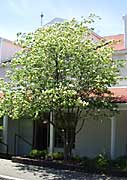


Home
Flowers &
Indoor Plants
Fruits & Nuts
Ornamentals
Vegetables
Special Topics
Resources
Glossary

|
Washington Hawthorn Crataegus phaenopyrum (crah-tay-gus fay-no-py-rum) 



Click on thumbnails for larger image. |
 |
What about it? The Washington hawthorn, is a native deciduous tree that commonly grows to a height of 20 to 25 feet. Hawthorn foliage is a reddish-purple color in the spring and the fall, and dark green in the summer. The flowers emerge as white clusters in the late spring. The fruit of the hawthorn tree is edible. It is often used to make jellies, and appears in clusters in the fall. Hawthorns twigs are covered with large thorns and are low to the ground; this is important to consider when planting. What is it used for? The hawthorn is a popular tree for landscaping. Since it is a medium-sized tree it is often used around buildings and in parks, since it will not "dwarf' buildings or people. The flowers and the orange fruits provide a colorful addition to a green space year round. Where does it grow? How do we grow it? The hawthorn will adapt well in many situations. The only important consideration is to provide the tree with partial shade. Plant the trees 10 feet apart Thorns are long, sharp, and can be hazardous. What are its primary problems? Hawthorns, though attractive ornamentals, are plagued by many serious pest problems. C. phaenopyrum is less susceptible to leafspot fungus than other hawthorns, but is still attacked by fireblight, rust, mildew, aphids, borers, etc.
© Copyright, Department of Horticulture, Cornell University. |